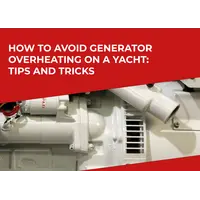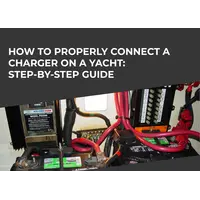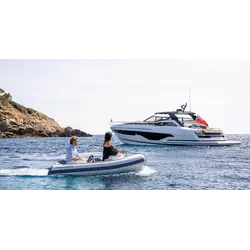In this article, topRik experts share their practical experience to help boat and yacht owners extend the life of their batteries and make them a reliable source of electrical power on board.
On powerboats and sailing yachts, batteries are discharged deeper, and the engine operating time is not enough to fully charge them. An attempt to apply automotive experience to boat batteries leads to the fact that expensive batteries last only 1-2 years and after that they lose capacity and fail.
At our marketplace you can select and buy the most popular types of marine batteries for yachts and boats, as well as select the appropriate chargers for them. We present products from the world's best manufacturers of marine electrical equipment: Blue Sea Systems, Victron Energy, Ultimatron France, Varta AG and others.
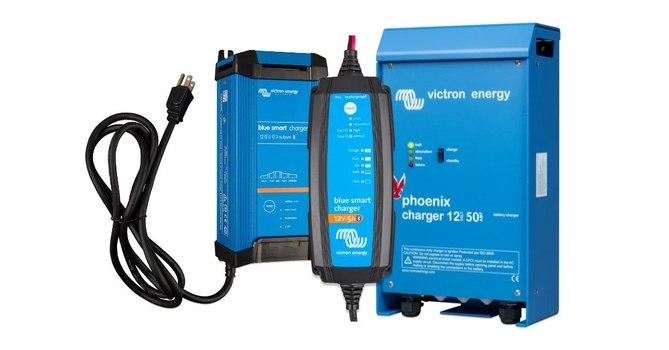
Basic Principles of Charging Different Types of Batteries
Yachts, boats and other river or sea vessels require special boat batteries to power electric motors (traction) or to start internal combustion engines (starter).
In order for ship batteries on yachts or boats to withstand pitching, vibration and not be afraid of shocks and moisture, their plates are reinforced with special gaskets with fiberglass and packed in separators - envelopes with a tight fit of all parts, operating in the mode of maintaining voltage for a long time, with regular deep discharges up to 70-80% and frequent recharging.
Batteries on a yacht, when recharged, can gain 100% power even after a long stay in a discharged state. They work without problems in humid environments. The internal bottom and walls are reinforced with additional stiffening ribs, and the connections of the grids with the current leads are made thicker. These are quite heavy batteries.
Starter batteries are similar in principle to automobile engines and are used to quickly start a gasoline or diesel engine. Within a few seconds they supply the large current required by the starter. Their reserve capacity is sufficient to power low-power electrical appliances, but they are not designed for long-term power supply of serious equipment or for frequent discharge loads.
Traction boat batteries for electric motors are designed on a different principle. Their task is to maintain a constantly high current value necessary for continuous operation of the electric motor, on-board systems, lighting or other energy consumers.
The thickened design of their plates resists oxidative processes that occur under heavy discharge loads; the number of discharge/charge cycles also increases many times over, which significantly extends the service life.
Such batteries are usually called deep-discharge batteries operating in cyclic mode Deep Cycle. They are characterized by a long service life, high reliability and are able to withstand the harmful effects of a discharged state.
Dual-purpose batteries combine both functions: they have the power to quickly start the engine and at the same time are able to supply electricity for a long time, powering equipment that is not too energy-intensive. Using a single power source is convenient on small craft with limited space or carrying capacity limits.
Understanding the key differences between traction and starter batteries is important when selecting the appropriate power source for your specific marine equipment needs. Here are some significant differences between these two types of batteries:
- Voltage and capacity. Traction batteries often have a higher voltage and significantly larger capacity compared to starter batteries. This ensures stable power supply for high power consuming devices over long periods of time.
- Discharge current and cold start current. Starter batteries are designed for high cold start current, which is necessary to instantly start the car engine. Traction batteries, on the other hand, provide a stable discharge current over longer periods.
- Cyclic durability. Traction batteries have high cycle life, making them an ideal choice for systems with frequent charge and discharge cycles, such as electric vehicles. Starter batteries, on the other hand, are optimized for the short-term high currents characteristic of the engine starting process.
- Durability and service life. Traction batteries, due to their design, provide a long service life with proper use and maintenance. Starter batteries, although they have high instantaneous energy, may have a more limited life, especially with frequent discharge cycles.
All batteries that are used on the market today can be divided into the following groups:
- WET - classic batteries, the electrolyte in them is in liquid form;
- AGM is an improved version of the battery, in which the liquid electrolyte was replaced with absorbent mats impregnated with electrolyte solutions;
- GEL – the electrolyte in such batteries is in gel form;
- Li-ion – with lithium ions as the main component of electrochemistry.
It is worth dwelling on each of these battery modifications in more detail.
WET Batteries
This is the largest and still most popular category for boat and car starter batteries, as well as for most traction models. This is a classic version of lead-acid batteries, which contain an electrolyte solution inside. Separators are used as dielectric spacers. The negative grilles in such batteries can be either stamped or cast. Modern versions of WET batteries are based on doping with calcium and other additives. Batteries produced using calcium technology last longer and require less maintenance.
Cheaper options are alloyed with antimony; the most expensive versions use silver in addition to calcium. Such additives can increase the battery life, make it more reliable and safe. Modern battery models use fiber separators. The grids are often produced using forging, and the composition of the active mass is constantly modified to improve the battery’s characteristics.
Batteries using EFB technology stand out separately in this category. This technology significantly increases the number of discharge and charge cycles that a battery can endure. When discharged to 80%, such a battery can be recharged more than 450 times. EFB batteries have a service life of up to six years.
Top 5 Lithium Battery 12.8V (LiFePO4)
Among the advantages of WET batteries are an affordable price, a wide selection of modifications: you can buy batteries with direct or reverse polarity, with different types of terminals, and different housing configurations. Among the disadvantages are a short service life, the possibility of toxic fumes, and the negative impact of deep discharges on the condition of the battery.
AGM Batteries
AGM technology batteries are a more modern option. They are used primarily for water transport, but in recent years they have become increasingly popular among car owners. Such batteries have a relatively small number of cycles that they can withstand, but they deliver current better and can work in any position. Since the plates are constantly in contact with the electrolyte, a short circuit in such batteries is excluded. The battery delivers high operating currents even if turned upside down.
The special design and the absence of evaporation allows you to extend the battery life. Depending on operating conditions, they can last up to 10 years or longer. The plates in such batteries deteriorate much more slowly.
Withstands up to 700 discharge and charge cycles.
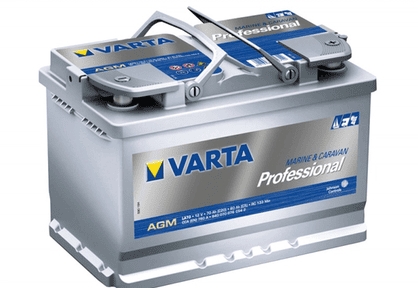
GEL Batteries
Like batteries using AGM technology, gel batteries do not have liquid electrolyte inside, but its composition is completely different. As an electrolyte, GEL batteries use a mixture of silicon oxides, which has a thick consistency. This completely eliminates short circuits between the battery plates. During operation, the electrolyte does not evaporate and constantly covers the plates. Even without the addition of alloying components, such batteries last more than 10 years.
The main disadvantage of GEL batteries is their relatively high cost.
But there are also a number of undeniable advantages: the service life of some models reaches 25 years with proper operation, the maximum number of charge and discharge cycles, with a discharge of up to 80% - more than 1200.
Li-ion Batteries
Lithium-ion batteries are widely used on boats and yachts primarily due to their light weight. A 12-volt 100 Ah battery weighs about 10 kg, while a lead-acid battery of the same capacity weighs more than 30 kg. But despite its modest dimensions, the useful capacity of a LiFePO4 battery is 2-3 times greater than that of a lead-acid battery. In addition, it is not subject to sulfation, allows cyclic use and deep discharge.

Real operating conditions for batteries on boats differ from test conditions. Therefore, the actual battery life never reaches the values specified in the manufacturers' specifications. Conventional lead-acid batteries can withstand 150-200 charge/discharge cycles and fail long before they have completed at least half the cycles measured on the manufacturer's measuring bench. Under the same conditions, lithium batteries last 3-4 times longer.
When choosing a specific model for starting and traction batteries, you should take into account some points that differ when charging different types of batteries.
For example, the higher the charge of a lead-acid battery, the less current must be supplied to it. In order not to damage the battery when the charge is 75-80%, the charger switches to constant voltage mode and the battery itself determines what current it needs.
This step lasts from 4 to 8 hours and is very important for lead-acid batteries, but due to lack of time on boats it is often neglected. Charging time is reduced, but at the same time the available capacity decreases, which for a lead-acid battery is only 30-35% of the nominal one.
Lithium boat batteries have up to 80% of their rated capacity. They can be discharged up to 20% and charged up to 100%.
The current consumed by the LiFePO4 battery remains constant throughout the entire charging time and only decreases rapidly at the very end. Therefore, even if charging ends at a voltage of 13.8-14.0 V , the constant voltage stage may last only 10-30 minutes. If you increase the charging end voltage to 14.4 V, this step will not be needed at all.
On the topRik trading platform we offer a large selection of different models and modifications of marine batteries for all of the above technologies. This gives you the opportunity to select the appropriate battery for any needs of the yacht - both starter and traction.
Battery Charging Process
Service batteries on a boat or yacht are designed to power on-board equipment. In addition to the service group, the vessel can be equipped with batteries for a thruster, a boat electric motor or an anchor winch. If we consider that each group of traction batteries may have different voltage, capacity and chemical composition, then the correct organization of their charging becomes a difficult task.
The solution consists of several stages. First of all, choose a charger that has sufficient power, has profiles for charging the main types of traction batteries and is equipped with two or three outputs. Then an isolation device is selected for charging several battery groups from the propulsion engine generator. This can be either a relay or a battery divider of the appropriate rating.
Autonomous navigation is impossible without monitoring the condition of the batteries. In the simplest case, a voltmeter is used, but devices that combine a voltmeter, an ammeter and an ampere hour meter in one housing are much more informative and accurate. The battery monitor can be designed to work with one group or to monitor multiple charging sources and batteries
If traction batteries power powerful consumers, for example, an inverter, they must be protected from deep discharge. Special devices designed for this disconnect the load as soon as the battery voltage drops below 11.5-12.0 V. Protection devices are also installed in the case when a single battery is used both to start the engine and to power on-board equipment.
On the water, traction batteries are charged from the generator of the propulsion engine of a boat or yacht. However, due to the way the generator operates, charging traction batteries takes too long and leads to increased fuel consumption and additional wear if the engine is started specifically to charge the batteries. Special chargers increase the charging efficiency of the generator, and additional charging sources, such as solar panels, recharge the batteries while the engine is not running.
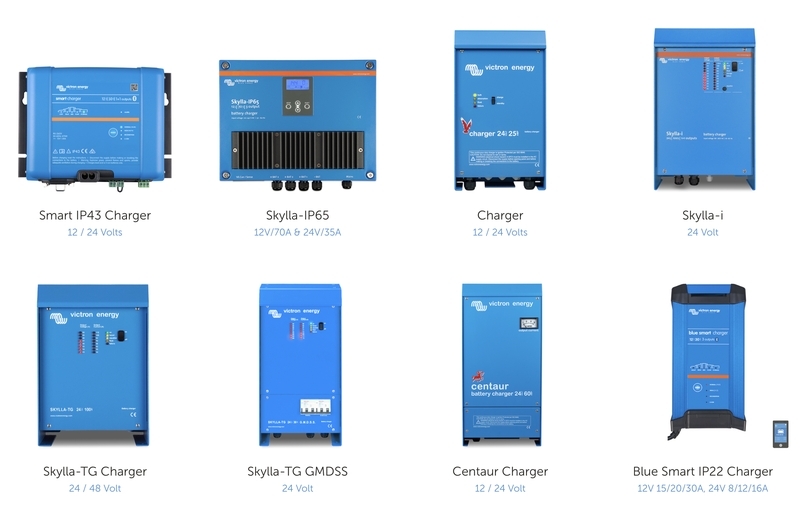
How To Properly Connect the Charger to the Battery
The starting battery lasts on a yacht for 5-7 years and can withstand thousands of engine starts during operation. But as soon as you discharge it to 50% capacity 30-40 times, the battery will immediately fail. Thin plates will not withstand cyclic load and will collapse.
To ensure that the battery can withstand hundreds of charge-discharge cycles without damage, the grids of the battery plates are made thicker, the porous active material is replaced with a dense one, and the plates themselves are wrapped in durable fiberglass. Such batteries are called traction batteries.
Since the design and operating methods of starting and traction batteries are different, these batteries also need to be charged differently.
What Are Digital Battery Switches and How Do They Work on Yachts
Selecting the Correct Charging Mode for Your Battery Type. Setting The Charging Voltage and Current
A generator with a constant output voltage is used to charge the starting batteries.
First, the battery provides electrical energy to the starter and excites the generator. The generator then returns the spent charge to the battery.
But the purpose of the battery is not limited to just starting the engine. At the same time, the battery serves as a load for the generator and helps it maintain a stable voltage in the electrical system. Without a battery, the voltage would fluctuate sharply every time the on-board equipment is turned on and off. Therefore, a running generator must always be connected to the battery.
The optimal installation option is a starting lead-acid battery (AGM or with liquid electrolyte) and a service lithium iron phosphate battery. To charge the service battery, a DC-DC charger is used, which limits the current and regulates the charging voltage of the lithium boat battery.
The LiFePO4 battery is capable of starting the engine even if the cell voltage drops to 3.0 V. However, the relatively high cost and complexity of the lithium battery do not justify its use. A dedicated lead-acid battery is more suitable for this purpose. It is easy to keep charged either with a shore charger or with a small solar panel. With proper maintenance, the service life of a starting battery with liquid electrolyte on ships is 7 years or more.
The process of charging traction batteries can consist of several stages. For each of them, the charger sets its own voltage value. There may be 3-4 such stages, depending on the type of traction battery.
A properly selected charger significantly extends the service life of traction batteries.
For each type of traction lead-acid battery, a modern charger has its own regulations:
- batteries with liquid electrolyte are charged at a voltage of 14.8 V, and then desulfated at 15.1-15.5 V;
- traction gel and AGM batteries are charged at a voltage of 14.2-14.4 V;
- sealed liquid acid charge at a voltage of 14.4 V.
Some charger models allow you to create a voltage profile according to the owner’s needs - for any type of traction battery.

Since chargers for traction boat batteries have to work in high humidity and strong vibration, models for open boats are produced in sealed and shockproof housings. But if there are rooms on the boat or yacht that are inaccessible to direct water, protection class IP22 is sufficient. Electronic components in such models are protected from moisture by polymer films.
Before you buy a charger:
- Find out the type of batteries. For gel, AGM and liquid acid batteries, the permissible charging current is different.
- If the battery consists of several traction batteries connected in parallel, the charger must be powerful enough. Recommended charger current – minimum 10% of battery capacity.
- Make sure that the charger output voltage ripple level is 5% or less, the efficiency is 85-90%, and the power factor is close to 1.
But keep in mind that the charge voltage differs for batteries of different brands, so first of all follow the manufacturers’ recommendations, and not the type of traction battery.
The charging current also depends on the type of battery and is determined as a percentage of the C20 capacity. The higher the current, the faster the charging, but the greater the danger of overheating and destroying the battery. Permissible maximum current for different types of traction batteries:
- lithium batteries – 100% C 20;
- AGM batteries – 30-50% C 20;
- gel – up to 30% C 20;
- batteries with liquid electrolyte -10-25% C 20.
Signs of Correct and Incorrect Charging
If the voltage for charging the battery is selected incorrectly, the following violations are possible:
- at low voltage, sulfation develops in the active material and the battery capacity quickly drops;
- at increased voltage, the grids of the positive plates corrode, the gas pressure in the housing increases, it comes out and carries away part of the electrolyte.
Since it is impossible to replenish water loss in gel and AGM batteries, overcharging is not permitted for these batteries.
We list the main errors when charging a battery, their consequences and methods of prevention.
The battery is left in a discharged state for a long time. Sulfation occurs, which reduces the battery capacity. Install the on-board charger and charge the battery if you have used it for more than 30 minutes.
Low charging voltage. The inner regions of thick plates remain undercharged. The battery is not charging 100%. The operating time of the equipment is less than it could be. Sulfation and loss of capacity occurs . Use a charger that has a mode for your battery type. The higher the charging voltage, the more energy the battery saves. Make sure to desulfate batteries.
Recharging the battery. The electrolyte releases gas, the battery loses water and the plates dry out. Dangerous for GEL and AGM batteries. Use an automatic charger with an algorithm for your battery type.
Charging with excessively high current. The battery heats up, the plates warp, a short circuit occurs between them and the battery fails. Use a temperature compensated charger. The temperature sensor must be installed on the battery. The charger reduces the voltage if the battery temperature rises.
Incorrect storage mode. During storage, batteries discharge and sulfation begins. The most dangerous thing is for batteries with liquid electrolyte. Install an on-board charger with float charging mode. Leave the charger turned on when storing batteries for a long time.
Please note that the topRik marketplace offers an extensive catalog with prices for chargers from the world's best manufacturers of marine electrical equipment. From us you can buy a charger that will fully match the type of batteries installed on your yacht.
Overcharging and Undercharging. Dangers and Consequences
With regular undercharging, insoluble lead sulfate crystals form on the battery plates, which greatly reduce the performance of the traction battery. Lead sulfate increases resistance, causing the charger to incorrectly set the charge voltage and further undercharging the battery.
Batteries with sulfated plates cannot be returned to normal and must be replaced, so charge batteries fully and equalize wet batteries every six to eight weeks.
Overcharging has especially tragic consequences for gel and AGM batteries. With constant recharging, the electrolyte boils away, and thermal runaway occurs, in which the battery becomes hotter and hotter.
REMEMBER
- The traction battery lasts longer if it is discharged to 30-50% of its capacity.
- A discharge of 70 percent is the maximum safe value.
- Do not leave batteries discharged for long periods of time.
- Charge batteries after each use.
- Do not mix old and new batteries into the same battery.


